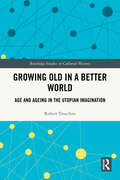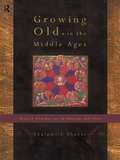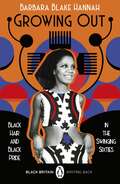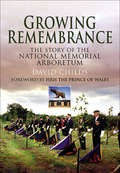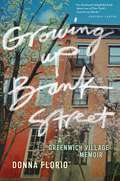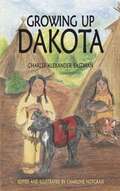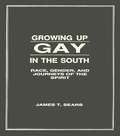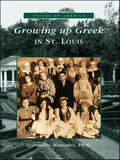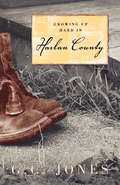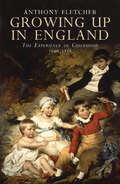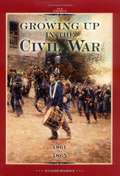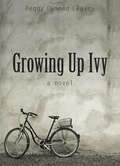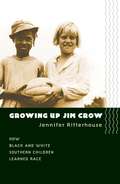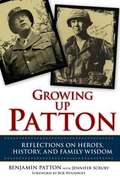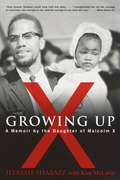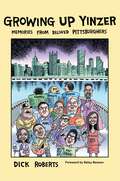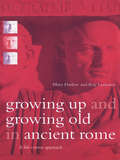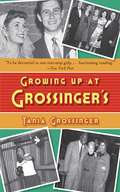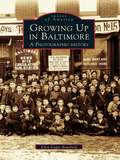- Table View
- List View
Growing Explanations: Historical Perspectives on Recent Science
by M. Norton WiseFor much of the twentieth century scientists sought to explain objects and processes by reducing them to their components--nuclei into protons and neutrons, proteins into amino acids, and so on--but over the past forty years there has been a marked turn toward explaining phenomena by building them up rather than breaking them down. This collection reflects on the history and significance of this turn toward "growing explanations" from the bottom up. The essays show how this strategy--based on a widespread appreciation for complexity even in apparently simple processes and on the capacity of computers to simulate such complexity--has played out in a broad array of sciences. They describe how scientists are reordering knowledge to emphasize growth, change, and contingency and, in so doing, are revealing even phenomena long considered elementary--like particles and genes--as emergent properties of dynamic processes. Written by leading historians and philosophers of science, these essays examine the range of subjects, people, and goals involved in changing the character of scientific analysis over the last several decades. They highlight the alternatives that fields as diverse as string theory, fuzzy logic, artificial life, and immunology bring to the forms of explanation that have traditionally defined scientific modernity. A number of the essays deal with the mathematical and physical sciences, addressing concerns with hybridity and the materials of the everyday world. Other essays focus on the life sciences, where questions such as "What is life?" and "What is an organism?" are undergoing radical re-evaluation. Together these essays mark the contours of an ongoing revolution in scientific explanation. Contributors. David Aubin, Amy Dahan Dalmedico, Richard Doyle, Claus Emmeche, Peter Galison, Stefan Helmreich, Ann Johnson, Evelyn Fox Keller, Ilana Lwy, Claude Rosental, Alfred Tauber
Growing Into Light: A Guidebook In Huna Magic
by Max Freedom LongFirst published in 1955, this book follows on from author Max Freedom Long’s previous publications on Huna magic, here providing the reader with a workbook to strengthen their skills through daily practice.Long offers powerful teachings that are reinforced with exercises and affirmations at the end of each chapter—teachings that were passed down verbally through the ages by Polynesian kahunas, or “Keepers of the Secret,” and preserved by those Long had met. By practicing the lessons in this book, the reader can truly grow in positive spiritual ways.Max Freedom Long is a masterful storyteller and employs many inspiring lessons and true stories that demonstrate the power of Huna at work. Anyone with a general interest in Huna magic will benefit from this powerful book. It represents the next step for those who want to benefit from practical instructions, now at their disposal, and move beyond having a general reading interest in the subject.
Growing Old in America: The Bland-Lee Lectures Delivered at Clark University
by David Hackett FischerA history of aging in America surveys and compares actualities and attitudes in the eighteenth, nineteenth, and twentieth centuries and suggests practical improvements on the current inadequate system of pensions, social security, medicare, and other programs.
Growing Old in a Better World: Age and Ageing in the Utopian Imagination (Routledge Studies in Cultural History)
by Robert TroschitzAs utopias question social ills and express human wants and unfulfilled dreams, they offer insights into the problems, desires and ideals of a certain time. This book uses this lens to examine cultural representations of ageing and old age in utopian writings from the Renaissance till today.The individual chapters offer detailed analyses and interpretations of numerous utopias from Thomas More’s Utopia (1516) to contemporary science fiction. Through close readings, the book explores age-related fears and ideals and investigates how perceptions of ageing and the life course as well as attitudes towards older people have developed over the centuries. Covering a large time span and a broad range of different utopias, the book identifies long-term developments and also puts certain dreams such as that of ever-lasting youth into a wider perspective. It thus enriches both our understanding of the cultural history of ageing and the history of utopian thought.The book will appeal to scholars and students from the fields of cultural gerontology and utopian studies, as well as literary studies and cultural history more generally.
Growing Old in the Middle Ages: 'Winter Clothes Us in Shadow and Pain'
by Shulamith ShaharThe social realities of old age have undergone profound changes since the middle ages. This study shows, however, that the images, attitudes and expectations of old people have changed for less. Shulamith Shahar shows how the status and social participation of the elderly varied according to gender, social stratum, economic resources, position, level of functioning, and personality, as well as according to regional custom. The book offers a broad cultural history of old age in medieval western Europe. Shahar examines the images, attitudes and advocated norms used in relation to the elderly and looks at the elderly in various social strata: churchmen and nuns, rulers, small office holders and soldiers, town dwellers and peasants. A valuable insight into life and society in the Middle Ages, this will prove an invaluable addition to history reading lists.
Growing Out: Black Hair and Black Pride in the Swinging 60s (Black Britain: Writing Back #9)
by Barbara Blake Hannah'A gorgeously exuberant account. . . writing that is natural and vivacious . . . a fascinating and hugely enjoyable read.' Bernardine Evaristo, from the IntroductionTravelling over from Jamaica as a teenager, Barbara's journey is remarkable. She finds her footing in TV, and blossoms. Covering incredible celebrity stories, travelling around the world and rubbing shoulders with the likes of Germaine Greer and Michael Caine - her life sparkles. But with the responsibility of being the first black woman reporting on TV comes an enormous amount of pressure, and a flood of hateful letters and complaints from viewers that eventually costs her the job.In the aftermath of this fallout, she goes through a period of self-discovery that allows her to carve out a new space for herself first in the UK and then back home in Jamaica - one that allows her to embrace and celebrate her black identity, rather than feeling suffocated in her attempts to emulate whiteness and conform to the culture around her.Growing Out provides a dazzling, revelatory depiction of race and womanhood in the 1960s from an entirely unique perspective.A title in the Black Britain: Writing Back series - selected by Booker Prize-winning author Bernardine Evaristo, this series rediscovers and celebrates pioneering books depicting black Britain that remap the nation.
Growing Pains: A Study of Teenage Distress
by Edna M. IrwinFirst Published in 1978. Routledge is an imprint of Taylor & Francis, an informa company.
Growing Public
by Peter H. LindertGrowing Public examines the question of whether social policies that redistribute income impose constraints on economic growth. Taxes and transfers have been debated for centuries, but only now can we get a clear view of the whole evolution of social spending. What kept prospering nations from using taxes for social programs until the end of the nineteenth century? Why did taxes and spending then grow so much, and what are the prospects for social spending in this century? Why did North America become a leader in public education in some ways and not others? Lindert finds answers in the economic history and logic of political voice, population aging, and income growth. Contrary to traditional beliefs, the net national costs of government social programs are virtually zero. This book not only shows that no Darwinian mechanism has punished the welfare states, but uses history to explain why this surprising result makes sense. Contrary to the intuition of many economists and the ideology of many politicians, social spending has contributed to, rather than inhibited, economic growth.
Growing Remembrance: The Story of the National Memorial Arboretum
by David ChildsThe story of the inspiration for, establishment and evolution of the National Memorial Arboretum is a fascinating one. Sited at Alrewas, Staffordshire, the Arboretum has become the Nations all year round focus for remembering and paying tribute to all who have served their country in both peace and war not only in the armed forces and merchant navy but in the emergency services as well.Planting began in 1997 and was supported by hundreds of organizations both serving and retired. Among the early memorials was a life-size wooded polar bear, for 49th Division, a grove of Irish trees for the Royal Irish Regiment, an Avenue of Chestnuts for the Police and a Chapel of Peace and Forgiveness to mark the coming of the Millennium. Britains war-widows had a rose-garden planted for them while the Far East Prisoners of War managed to fund a small museum to stand alongside a length of railway track brought back from the notorious Burma Railway. In October 2007 H.M. the Queen confirmed the importance of the site when she opened the Armed Forces Memorial to commemorate all service personnel lost on active service since the end of the Second World War; this is especially poignant given the ongoing conflicts in Iraq and Afghanistan. The importance of the National Memorial Arboretum is well demonstrated by the growing number of stands and the steady increase in visitor numbers.
Growing Up Bank Street: A Greenwich Village Memoir (Washington Mews Books)
by Donna FlorioA vivid memoir of life in one of New York City’s most dynamic neighborhoodsGrowing Up Bank Street is an evocative, tender account of life in Greenwich Village, on a unique street that offered warmth, support, and inspiration to an adventurous and openhearted young girl. Bank Street, a short strip of elegant brownstones and humble tenements in Greenwich Village, can trace its lineage back to the yellow fever epidemics of colonial New York. In the middle of the last century, it became home to a cast of extraordinary characters whose stories intertwine in this spirited narrative. Growing up, Donna Florio had flamboyant, opera performer parents and even more free-spirited neighbors. As a child, she lived among beatniks, artists, rock musicians, social visionaries, movie stars, and gritty blue-collar workers, who imparted to her their irrepressibly eccentric life rules. The real-life Auntie Mame taught her that she is a divine flame from the universe. John Lennon, who lived down the street, was gracious when she dumped water on his head. Sex Pistols star Sid Vicious lived in the apartment next door, and his heroin overdose death came as a wake-up call during her wild twenties. An elderly Broadway dancer led by brave example as Donna helped him comfort dying Villagers in the terrifying early days of AIDS, and a reclusive writer gave her a path back from the brink when, as a witness to the attacks of 9/11, her world collapsed. These vibrant vignettes weave together a colorful coming of age tale against the backdrop of a historic, iconoclastic street whose residents have been at the heart of the American story. As Greenwich Village gentrifies and the hallmarks of its colorful past disappear, Growing Up Bank Street gives the reader a captivating glimpse of the thriving culture that once filled its storied streets.
Growing Up Dakota
by Charlene Notgrass Charles A. EastmanGrowing up Dakota is an autobiographical account of the boyhood of Ohiyesa, also known as Charles Eastman, a member of the Dakota nation. Used in Units 4-5 of the America the Beautiful curriculum. Grades 5-8.
Growing Up Gay in the South: Race, Gender, and Journeys of the Spirit
by James T SearsThis groundbreaking new book weaves personal portraits of lesbian and gay Southerners with interdisciplinary commentary about the impact of culture, race, and gender on the development of sexual identity. Growing Up Gay in the South is an important book that focuses on the distinct features of Southern life. It will enrich your understanding of the unique pressures faced by gay men and lesbians in this region--the pervasiveness of fundamental religious beliefs; the acceptance of racial, gender, and class community boundaries; the importance of family name and family honor; the unbending view of appropriate childhood behaviors; and the intensity of adolescent culture.You will learn what it is like to grow up gay in the South as these Southern lesbians and gay men candidly share their attitudes and feelings about themselves, their families, their schooling, and their search for a sexual identity. These insightful biographies illustrate the diversity of persons who identify themselves as gay or lesbian and depict the range of prejudice and problems they have encountered as sexual rebels. Not just a simple compilation of “coming out” stories, this landmark volume is a human testament to the process of social questioning in the search for psychological wholeness, examining the personal and social significance of acquiring a lesbian or gay identity within the Southern culture. Growing Up Gay in the South combines intriguing personal biographies with the extensive use of scholarship from lesbian and gay studies, Southern history and literature, and educational thought and practice. These features, together with an extensive bibliography and appendices of data, make this essential reading for educators and other professionals working with gay and lesbian youth.
Growing Up Getty: The Story of America's Most Unconventional Dynasty
by James ReginatoAn enthralling and comprehensive look into the contemporary state of one of the wealthiest—and most misunderstood—family dynasties in the world, perfect for fans of Succession and House of Gucci.The Gettys are one of the wealthiest—and most misunderstood—family dynasties. Oil magnate J. Paul Getty, once the richest man in the world, is the patriarch of an extraordinary cast of sons, grandchildren, and great-grandchildren. While some have been brought low by mental illness, drug addiction, and one of the most sensational kidnapping cases of the 20th century, many of Getty&’s heirs have achieved great success. In addition to Mark Getty, a cofounder of Getty Images, and Anne G. Earhart, an award-winning environmentalist, others have made significant marks in a variety of fields, from music and viniculture to politics and LGBTQ rights. Now, across four continents, a new generation of lively, unique, and even outrageous Gettys is emerging—and not coasting on the dynasty&’s still-immense wealth. August Getty designs extravagant gowns worn by Katy Perry, Cher, and other stars; his sibling, Nats—a fellow LGBTQ rights activist who announced his gender transition following his wedding to transgender icon Gigi Gorgeous—produces a line of exclusive streetwear. Their fascinating cousins include Balthazar, a multi-hyphenate actor-director-DJ-designer; and Isabel, a singer-songwriter and MBA candidate. A far-flung yet surprisingly close-knit group, the ascendant Gettys are bringing this iconic family onto the global stage in the 21st century. Through extensive research, including access to J. Paul Getty&’s diaries and love letters, and fresh interviews with family members and friends, Growing Up Getty offers an enthralling and revealing look into the benefits and burdens of being part of today&’s world of the ultra-wealthy.
Growing Up Greek in St. Louis (Voices of America)
by Aphrodite Matsakis Ph.D.Since the beginning of the 20th century, St. Louis' Greek-American community has been a vibrant part of the city's fabric. Through a series of vivid personal accounts of growing up in two worlds during the post-WWII era, Growing Up Greek in St. Louis explores the challenges faced by Greek-Americans as they sought to preserve a rich cultural heritage while assimilating to American ways.From a detailed account of her Grandmothers' struggles during the occupation of Greece during WWII and the Asia Minor Holocaust to the first hand experiences faced by Greek-American children in Greek school, the celebration of name days, and the ever-present "evil eye," the book captures the sense of tradition, history, hospitality (philotimo), and community so vital to the Greek experience.
Growing Up Hard in Harlan County
by G. C. JonesThis classic memoir is “an absorbing tale” of life in Appalachian Kentucky during the Great Depression (The Washington Post).G.C. “Red” Jones’s classic memoir of growing up in rural eastern Kentucky during the Depression is a story of courage, persistence, and eventual triumph. His priceless and detailed recollections of hardscrabble farming, of the impact of Prohibition on an individualistic people, of the community-destroying mine wars of “Bloody Harlan,” and of the drastic dislocations brought by World War II are essential to understanding this seminal era in Appalachian history.“An absorbing tale told in the vernacular language of the teamsters, farmers and miners in rural, mountainous Kentucky in the early decades of this century. The narrative flows with the symmetry that comes naturally to the accomplished storyteller.” —TheWashington Post“Draws the reader into a sometimes frightening world of survival.” —Lexington Herald-Leader“He bears witness to Harlan County—first as a community of self-sufficient farmers, then as a mining area and finally in the 1930s as ‘bloody Harlan’ . . . Mr. Jones celebrates horses and mules, the bounty of the hillside farms and woods and the rough ingenuity, honor and sweetness of the mountain people.” —The New York Times“Jones shows all of us that fierce determination, lived day by day, can lead to a satisfying life, even though it might be hard.” —Kentucky Monthly
Growing Up In England
by Anthony FletcherThis book presents an entirely fresh view of the upbringing of English children in upper and professional class families over three centuries. Drawing on direct testimony from contemporary diaries and letters, the book revises previous understandings of parenting and what it was like to grow up in the period between 1600 and 1914. Using advice literature which set out developing ideologies of childhood, gender and parenting, the book explores the separate but complementary roles of mothers and fathers in raising their children. Male upbringing is discussed in terms of schooling, female through the moral and social context of a domestic schoolroom dominated by a governess. Boys were trained for the world, girls for society and marriage. Rare teenage diaries surviving from the Georgian and Victorian periods show teenagers speaking for themselves about education; relationships with parents, siblings and friends; and their social, class and gender identity.
Growing Up In The Civil War, 1861 To 1865 (Our America)
by Duane DamonLook at life through the eyes of children who lived during different eras of American history... Experience the thrill of landing in the New World for the first time and the terror of dodging bullets during the American Revolution. Journey to the American West in the back of a covered wagon and discover the horrors of the Civil War. From the technological advances of the early twentieth century to the despair of the Great Depression to the sacrifice of World War II, explore each tumultuous time. Our America reveals the true-life adventures of children (many of whom grew up to become presidents or other important national figures), through features such as historical sidebars, quotes from primary resources like diaries and letters, epigraphs, and art authentic to each era. Supports the national curriculum standards Culture; Time, Continuity, and Change; Individual Development and Identity; Individuals, Groups, and Institutions; Power, Authority, and Governance; Global Connections; and Civic Ideas and Practice as outlined by the National Council for the Social Studies.
Growing Up Ivy
by Peggy Dymond LeaveyCommended for the 2011 Best Books for Kids and Teens Living in grim Depression-era Toronto with her actress mother, Frannie, Ivy Chalmers has never met her father. In 1931, Frannie sends twelve-year-old Ivy to stay with her paternal grandmother in Larkin, Ontario, while she seeks stardom in New York City. When Ivy’s father, Alva, arrives unexpectedly in Larkin, he turns out not to be the Prince Charming she imagined, but an illiterate peddler. Rescuing Ivy from her uncompromising grandmother, Alva takes her with him for the summer, wandering the countryside by horse-drawn caravan, selling shoes. Back in Larkin at summer’s end, Ivy meets teenager Charlie Bayliss, orphaned as an infant and raised by his aunt on a farm outside town. Ivy has a flair for writing and boundless imagination, while Charlie loves baseball and loathes farming. Unknown to both of them, though, is a secret connection they share. When the final pieces of the puzzle of their lives fall into place, nothing will ever be the same.
Growing Up Jim Crow
by Jennifer RitterhouseIn the segregated South of the early twentieth century, unwritten rules guided every aspect of individual behavior, from how blacks and whites stood, sat, ate, drank, walked, and talked to whether they made eye contact with one another. Jennifer Ritterhouse asks how children learned this racial "etiquette," which was sustained by coercion and the threat of violence. More broadly, she asks how individuals developed racial self-consciousness. Parental instruction was an important factor--both white parents' reinforcement of a white supremacist worldview and black parents' oppositional lessons in respectability and race pride. Children also learned much from their interactions across race lines. The fact that black youths were often eager to stand up for themselves, despite the risks, suggests that the emotional underpinnings of the civil rights movement were in place long before the historical moment when change became possible. Meanwhile, a younger generation of whites continued to enforce traditional patterns of domination and deference in private, while also creating an increasingly elaborate system of segregation in public settings. Exploring relationships between public and private and between segregation, racial etiquette, and racial violence, Growing Up Jim Crow sheds new light on tradition and change in the South and the meanings of segregation within southern culture.
Growing Up Patton
by Benjamin Patton Jennifer ScrubyThe grandson of the legendary World War II general George S. Patton Jr., documentary filmmaker Benjamin Patton, explores his family legacy and shares the inspirational wit and wisdom that his grandfather bestowed upon his only son and namesake. In revealing personal correspondence written between 1939 and 1945, General Patton Jr. espoused his ideals to Benjamin's father, then a cadet at West Point. Dispensing advice on duty, heroism and honor with the same candor he used ordering the Third Army across Europe, Patton shows himself to be as dynamic a parent as a military commander. Following in those famous footsteps, Benjamin's father became a respected and decorated hero of both the Korean and Vietnam wars. Ironically, as he rose to major general, he also proved himself just as brave, flamboyant, flawed and inspiring as his father had been. A study of a great American original, Growing Up Patton features some of the pivotal figures in Benjamin's father's life, including Creighton Abrams, the WWII hero who became his greatest mentor; Charley Watkins, a daredevil helicopter pilot in Vietnam; Manfred Rommel, the son of German Field Marshal Erwin Rommel; Joanne Patton, the author's mother and a resourceful fighter in her own right; and Benjamin's mentally challenged brother, George. Growing Up Patton explores how the Patton cultural legacy lives on, and in the end, reveals how knowing the history of our heritage--famous or not--can lead to a deeper understanding of ourselves. INCLUDES NEVER-BEFORE-PUBLISHED LETTERS BETWEEN GENERAL GEORGE S. PATTON AND HIS SON DURING WORLD WAR II INCLUDES NEVER-BEFORE-PUBLISHED FAMILY PHOTOGRAPHS
Growing Up X: A Memoir by the Daughter of Malcolm X
by Ilyasah Shabazz"Ilyasah Shabazz has written a compelling and lyrical coming-of-age story as well as a candid and heart-warming tribute to her parents. Growing Up X is destined to become a classic."-SPIKE LEEFebruary 21, 1965: Malcolm X is assassinated in Harlem's Audubon Ballroom. June 23, 1997: After surviving for a remarkable twenty-two days, his widow, Betty Shabazz, dies of burns suffered in a fire. In the years between, their six daughters reach adulthood, forged by the memory of their parents' love, the meaning of their cause, and the power of their faith. Now, at long last, one of them has recorded that tumultuous journey in an unforgettable memoir: Growing Up X.Born in 1962, Ilyasah was the middle child, a rambunctious livewire who fought for-and won-attention in an all-female household. She carried on the legacy of a renowned father and indomitable mother while navigating childhood and, along the way, learning to do the hustle. She was a different color from other kids at camp and yet, years later as a young woman, was not radical enough for her college classmates. Her story is, sbove all else, a tribute to a mother of almost unimaginable forbearance, a woman who, "from that day at the Audubon when she heard the shots and threw her body on [ours, never] stopped shielding her children."From the Trade Paperback edition.
Growing Up Yinzer: Memories from Beloved Pittsburghers (The History Press)
by Dick RobertsIn the Steel City, "Yinzer" is a term of endearment, reserved for the city's most beloved and embraced by locals as a symbol of the grit and determination that Pittsburgh endows anyone from there. The city's undeniable impact on the character and life of those who grew up there has shaped iconic figures of American sports, entertainment and culture. Legends of the gridiron such as Jim Kelly, Tony Dorsett, Dan Marino and Joe Namath forged their football prowess in Western Pennsylvania. Business pioneers including Mark Cuban, Ray Werner and Bill Strickland were ingrained with the value of hard work in the Steel City. Music and movie stars like Jeff Goldblum, George Benson and Billy Gardell found creative inspiration in Pittsburgh that led to new heights. Author Dick Roberts presents profiles, interviews and memories from some of the most famous and adored Pittsburghers.
Growing Up and Growing Old in Ancient Rome: A Life Course Approach
by Ray Laurence Mary HarlowThroughout history, every culture has had its own ideas on what growing up and growing old means, with variations between chronological, biological and social ageing, and with different emphases on the critical stages and transitions from birth to death. This volume is the first to highlight the role of age in determining behaviour, and expectations of behaviour, across the life span of an inhabitant of ancient Rome. Drawing on developments in the social sciences, as well as ancient evidence, the authors focus on the period c.200BC - AD200, looking at childhood, the transition to adulthood, maturity, and old age. They explore how both the individual and society were involved in, and reacted to, these different stages, in terms of gender, wealth and status, and personal choice and empowerment.
Growing Up at Grossinger's
by Tania Grossinger"To be devoured in one non-stop gulp...fascinating reading."-The New York Post From 1919 to 1986, Grossinger's Catskill Resort Hotel provided a summer retreat from the city heat for New York's Jews, and entertained the great, the near-great, and the not so great, Jews and Gentiles alike. A melting pot of the Borscht Belt, sports, and show-biz worlds, loyal visitors included Red Buttons, Rocky Marciano, Eddie Fisher, and Jackie Robinson. Tania Grossinger grew up there. In her fascinating insider's account of life in the hospitality industry, she sheds light on how hotel children keep up with the frenetic pace of life, and how they come to grips with the outside world (which intrudes now and again), sex (happening in every room), and, occasionally, their intellectual interests. Growing Up at Grossinger's is both a wonderful coming-of-age story and a sentimental reading of a chapter of the Jewish experience in America that has now closed. 25 b/w photographs.
Growing Up in Baltimore: A Photographic History (Images of America)
by Eden Unger BowditchChronicling the period from the mid-nineteenth century to the early 1900s through striking vintage photographs, Growing Up in Baltimore pays tribute to the enduring courage and spirit of children. In a city that has been, at once, blessed with a rich port and torn apart by war, filled with pristine parks and scarred by the ravages of industrial life, childhood has reflected the ever-changing times and culture in American life. From baseball games and trips to the zoo to schoolyard pals and amusement park rides, children explored the world around them. But the nostalgia and innocence of well-born youth mingled with the harsher realities that many boys and girls knew as their daily lives-laboring in the mills and factories, the haphazard destruction of fires and storms, the segregation of public places, the cold and hunger so keenly felt during the Great Depression.



